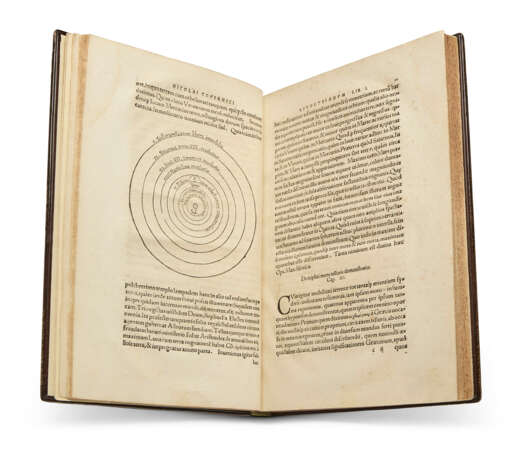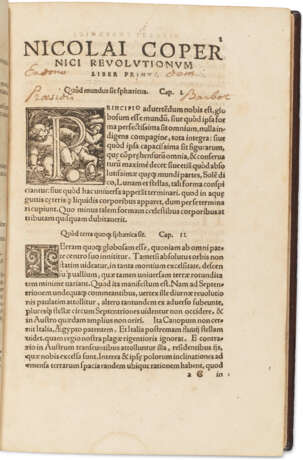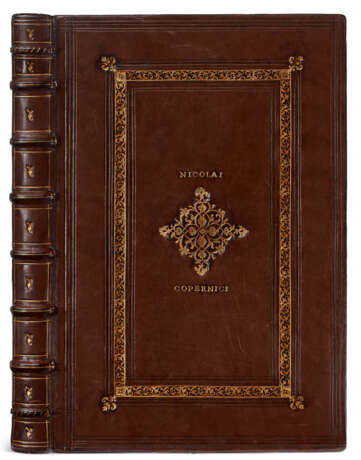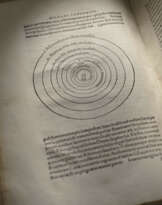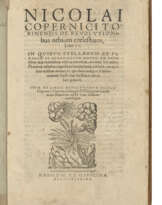ID 1360792
Lot 76 | De revolutionibus orbium coelestium
Valeur estimée
$ 60 000 – 80 000
An annotated copy of the second edition. The annotations, possibly by Valentin Otto, derive from those of Georg Rheticus (now lost). De revolutionibus placed for the first time the sun at the center of the heavens and described the earth's annual rotation around the sun and its diurnal rotation. Copernicus denounced the geocentric belief in the immobility of the earth as based on mere appearance. In order even to entertain the idea of heliocentrism, Copernicus had to break with virtually all current knowledge: astronomical, metaphysical, theological and, most basically, simple sensory perception. The geocentric system of Ptolemy had held sway for over a millennium; Aristotelianism dictated that there was a fundamental difference between heavenly and terrestrial bodies; and theological dogma considered geocentrism as the very foundation of the special relationship between God and man. Aware of the radical nature of his theory, Copernicus composed an introduction in which he attempted to trace historical antecedents for his basic tenets. He cites antecedents for the mobility of the earth in Pythagoras and Heraclides and for the earth's revolution around the sun in Aristarchus. While these antecedents provided a handy defense for Copernicus, it is unlikely that they played any significant role in developing his theory (cf. Owen Gingerich, Eye of Heaven, 1993). In the event, the Church never officially condemned Copernicus's work as heretical, in part because its observations were essential for reform to the calendar and thus to the precise determination of Easter.
The present edition is the first to contain Rheticus's Narratio prima, being a summary of heliocentrism and an account of the effort it took to persuade Copernicus to publish. Copernicus had first circulated his ideas on heliocentrism in manuscript form, catching the attention of the young mathematician and astronomer Georg Joachim Rheticus, who became the chief advocate of his new theory. Rheticus’ summary appeared in print in 1540, three years before the first edition of Copernicus’ own publication in Gdansk. The Gdansk edition was quickly followed by a pirated edition printed in Basel. The present volume is the second authorized edition of De revolutionibus and the first edition to unite the works of both Copernicus and his advocate, Rheticus. This copy is corrected according to the errata leaf of the 1543 edition and also with corrections continuing to the end. Most salient is the note on f.96, "'Joachimi Rh[etici]: Haec attigimus in nostra narratione sed praeceptor praeteriit. ('We touched on this in our Narratio [prima] but my teacher skipped over it.") That this entry is in the first person, though not in the hand of Georg Joachim Rheticus, suggests that this note and others were directly copied from Rheticus's own book, and hence the annotations in this copy give evidence for the nature and extent of annotations in Rheticus's copy of De revolutionibus. A likely candidate for the annotator is Valentin Otto, who collaborated with Rheticus in Cracow near the end of the latter's life, but no comparison with Otto's authenticated handwriting has so far been possible" (Gingerich census). This copy has Johann Schöner's name canceled on both the title-page and f.197 (beginning of the Narratio prima).
Petri’s edition reproduces almost exactly the main text of the 1543 edition, including Andreas Osiander's unsigned prefatory letter—an attempt to placate anticipated critics of the work by emphasizing its purely theoretical aspect. Petri added a prefatory recommendation by the noted astronomer Erasmus Reinhold (printed at the end of the index), stating that "all posterity will gratefully remember the name of Copernicus, by whose labor and study the doctrine of celestial motions was again restored from near collapse" (Owen Gingerich's translation, Eye of Heaven, p.221). In his census of the 1543 and 1566 editions, Owen Gingerich has located 317 copies of the second edition, making it only slightly less rare than the first. Adams C-2603; Gingerich, An Annotated Census of Copernicus' De revolutionibus (Nuremberg, 1543 and Basel, 1566), II.292; Houzeau & Lancaster 2503.
Folio (279 x 188 mm). Roman type, occasional Greek type. Woodcut diagrams, printer's device on title, woodcut historiated initials (lacking final leaf with anvil device, title-page worn and repaired, small dampstain on first several leaves, a scattered few browned leaves, small ink-burn on N3 touching a letter). Modern calf stamped in blind and gilt, modern quarter morocco case. Provenance: corrected with annotations possibly by Valentin Otto – "Praesides Barbot" (inscription on f.1 and canceled inscription on title) – Charles de Pradel, Bishop of Montpellier, 1644-1696 (ownership inscription on title, with loss at left) – [Guillaume?] Desbiey (purchase price at a sale of his books recorded in 1787) – Arnaud de Vitry (1926-2012; full-page bookplate bound in) – anonymous owner, sold Sotheby's, 3 November 1998, lot 92 – Alain Blanc-Brude (who sold it to Owen Gingerich, according to Gingerich's census).
| Artiste: | Nicolaus Copernicus (1473 - 1543) |
|---|---|
| Lieu d'origine: | Suisse |
| Catégorie maison de vente aux enchères: | Livres imprimés |
| Artiste: | Nicolaus Copernicus (1473 - 1543) |
|---|---|
| Lieu d'origine: | Suisse |
| Catégorie maison de vente aux enchères: | Livres imprimés |
| Adresse de l'enchère |
CHRISTIE'S 20 Rockefeller Plaza 10020 New York Etats-Unis | ||||||||||||||
|---|---|---|---|---|---|---|---|---|---|---|---|---|---|---|---|
| Aperçu |
| ||||||||||||||
| Téléphone | +1 212 636 2000 | ||||||||||||||
| Fax | +1 212 636 4930 | ||||||||||||||
| Conditions d'utilisation | Conditions d'utilisation | ||||||||||||||
| transport |
Service postal Service de messagerie ramassage par vous-même | ||||||||||||||
| Modes de paiement |
Virement bancaire | ||||||||||||||
| Heures d'ouverture | Heures d'ouverture
|
